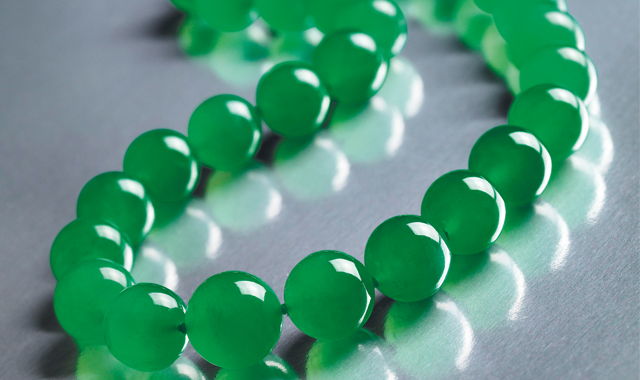The Appeal of Jade at Auctions
At the age of seven, Barbara Hutton inherited the equivalent of US$330 million today, after her mother, the daughter of Frank W. Woolworth, committed suicide. The heiress, dubbed “poor little rich girl,” went on to have an eventful life, marrying seven times, and was renowned for spending lavishly on anything that took her fancy, including glittering jewels, such as historical pieces that once belonged to Queen Marie-Antoinette, and the famed 40-carat Pasha Diamond, which she asked Cartier to re-cut, because she didn’t like its unusual octagonal brilliant-cut. For her first wedding in 1933 to Prince Alexis Mdivani, her father gave her a stunning jadeite bead necklace, which she first wore publicly at her 21st birthday celebrations. Created by Cartier, the necklace comprised 27 very large beads of brilliant green color and an excellent translucency, mounted with a ruby and diamond clasp. Hutton loved jadeite, and she collected numerous jade ornamental objects as well as jade jewels during her lifetime. The bead necklace appeared at a Christie’s auction in Hong Kong in 1994, selling for HK$33.02 million ($4.27 million at the time) and this stunning piece, with beads measuring 15.4 mm to 19.2 mm, will now be the star lot of Sotheby’s Magnificent Jewels and Jadeite auction on April 7.
“The quality of these beads is the best I have ever seen,” muses Terry Chu, deputy head of jewelry at Sotheby’s Asia, who expects it to attract well above the $5 million estimate. To put this into context, a jadeite necklace of 23 bright green beads with exceptional translucency and size measuring 17.35 to 20.71mm fetched HK$106.2 million ($13.7 million) at Tiancheng International’s auction in 2012, setting an auction record for a piece of jadeite jewelry.
“To come out with a nice jadeite bead necklace is one of the most difficult tasks, because unlike pearls, which you can acquire separately, all the beads have to come from the same boulder to look nice, so you can imagine the boulder will have to be pretty big to carve so many beads,” explains Chu. Sotheby’s will auction about 100 pieces of jadeite at the April 7 sale, including an oval jadeite bangle estimated at HK$42-50 million ($5.4-$6.45 million).
According to Graeme Thompson, head of department for jewelry at Bonhams Asia, jadeite jewelry has recently steadily increased in both interest and hammer prices as witnessed in various auctions last year. “In the past few years, due to decreasing exports of rough jadeite from Burma, prices have gone up significantly for finished jadeite jewelry, even more so for high quality jadeite offered in auctions,” Thompson says.
Jadeite, which is only mined in Burma, is a difficult gemstone to assess, as unlike precious stones, there is no international standard of grading.
According to Stewart Young, director of auction house Tiancheng International’s jewelry department, the quality of jadeite is predominantly determined by its fineness. The finer the crystal composition, the higher the translucency. Inclusions in the forms of grain lines (white cloud) and black spots visibly present within the material, can upset its assessed quality. The second crucial parameter is the color, Young explains.
Of course size matters too. A rough stone may contain growth lines, the concentration of color growth within the material as fractures or inclusions, and this would make it less attractive. A sizable finished piece of nearly perfect jadeite with fullness of color would therefore mean that it is made from a high-caliber rough stone with very scarce growth lines.
“One should pay attention to any major growth lines, also known as fractures, since they can potentially affect the material’s durability. Shrewd jewelry craftsmen often artistically work around such imperfections through decorative motifs, though some cutting of jadeite, such as the jadeite cabochon, which requires a much more stringent demand for perfection in order to produce the pristine dome surface,” Young points out.
Besides green, jadeite also comes in natural lavender, yellow, red, black (actually a very deep green and the result of a high iron content), and white (lacking chromophores).
Lavender has its own market amongst female collectors, Young notes, and can also fetch higher prices. Tiancheng International sold a lavender jadeite bead, and gem-set 'Tulip' necklace designed by Alessio Boschi last autumn for HK$3,068,000 ($395,609). Red is also popular with Asian clients, especially those from Mainland China. “In recent years, the brighter green or apple green color jadeite has become more popular, as this less saturated green tends to give a younger look compared to the traditional imperial green color,” Thompson notes.
Jadeite jewelry has long been associated with green beads and pendants, often with heavy Chinese carvings such as characters for good luck and long life, but Vickie Sek, deputy chairman of jewelry and jadeite at Christie's Asia, notes there has been a steady growth in contemporary jadeite design at auction in 2013. For example, last May, Christie’s sold the Orpheus Ring by Anna Hu, a large cabochon jadeite with multi-gem Orpheus for HK$20,030,000 ($2,582,808), five times its original estimate, while a pair of multi-gem ear pendants by Wallace Chan sold for HK$900,000 ($116,052).
As first published in Blouin Lifestyle Magazine.
